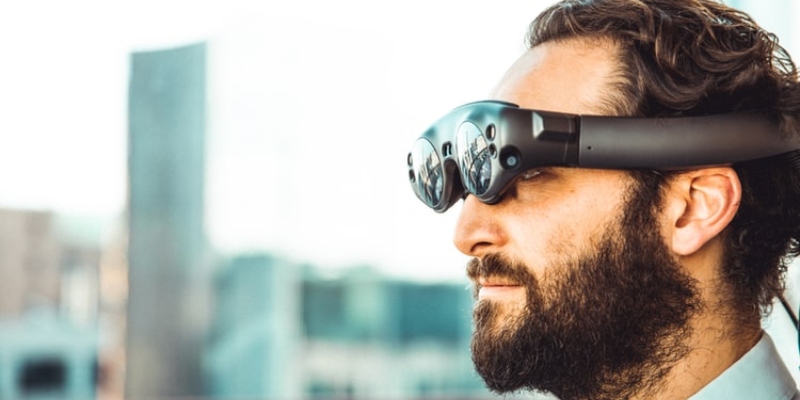Will AR Take Over Social Media and Online Casinos?

Augmented reality, or AR, is what a lot of people once had in mind for the future. It’s been a mainstay of sci-fi films for decades, but once the technology actually became available, it didn’t do as well as planned. Facebook has plans to launch new technology to try to change that. This new tech could impact social media, online casinos and more.
Augmented reality has been on the rise in the last year and is already being adopted by most of the biggest tech companies. According to Statista, the mobile AR market is worth almost US$9 billion, with 810 million active users worldwide. They forecast that that number will rise above a billion by 2022 and continue on the rise over the next several years.
Currently, AR technology is being used in all sorts of industries, like healthcare, public safety, and tourism. As more and more big companies research the technology and develop their own uses, we can expect it to become a bigger part of our daily lives, for both practical purposes and entertainment. Read on to discover how the technology works and how it could someday become a part of your day-to-day life.
What’s behind the technology
Virtual reality technology is based on ideas from as far back as the 1800s, around the time when photography was becoming popular. One of the earliest forms of this concept was View-Masters, which were a wearable slide carousel used to give the viewer a close-up look at photographs. There were also early forms of the expanded reality used in the cinema, with interactive films that made people feel like they were part of the action with multi-sensory stimulation and early varieties of 3D video tech.
Virtual reality as we know it really kicked off in the 1980s, when video technology started to be incorporated into the headsets. They were combined with other elements like sensory gloves that allowed the user to actually control what they were seeing—a long way past just viewing a still image in a pair of goggles. These days, virtual reality can be as simple as using a cardboard holder for a virtual reality smartphone app, or as complicated as full-body interactive experience.
Augmented reality isn’t the same as virtual reality, though they’re based on the same ideas and are often confused with one another. The biggest difference is that virtual reality usually gives you a simulated view through a headset but otherwise obscures your vision of what’s going on around you. The viewer ends up in their own little world—which is often quite desirable if you’re playing a really engrossing video game. Augmented reality, on the other hand, enhances what you’re actually seeing by superimposing digital images over your view.
So far, the tech has been used for all sorts of applications, from the practical to the fanciful. It can be used to do things like show you what a different paint colour would look like in your bedroom or project virtual arrows on the road so can see where you need to turn next. It’s been used in popular mobile games like Pokémon Go, which projects images of Pokémon onto your surroundings so you can “capture” them.

Applications like this just use the smartphone you already own, so they’re fairly easy for people to adopt. All you need is a good smartphone and a virtual reality app to get started. When AR is used on mobile applications, it combines what it sees through your device’s camera with other digital content to give you an on-screen AR experience.
But as expanded reality tech gets better, we’ve started to see plans for various AR headsets or wearables that let the user experience augmented reality without looking at their smartphone or tablet. This is likely the boost that augmented reality needs in order to take off in popularity, and there have been lots of rumours about how this technology could revolutionize social media, gaming and more. That’s where Facebook comes in.
What Facebook is developing
Facebook Reality Labs (FRL) started planning for AR glasses more than six years ago, with a project called Oculus Research. But they recently pivoted to a wrist-based solution, with an AR device similar to a watch. Their reasoning was that these devices would be less obtrusive than glasses and also allow for more private interaction. Eventually, FRL wants to produce a technology that feels really natural to the user—the device would be no larger than a wristwatch and you’d be able to use it without stopping what you’re doing or interfering with what’s going on around you.
Instead of relying on the motion of your hand, as you might think, Facebook’s idea is to use EMG, or electromyography. This technology essentially uses sensors that translate nerve signals in your wrist into digital commands. This kind of technology is fast, discreet and highly customizable, and it can detect movements as small as a millimetre. FRL has already given promos of how you could use the device to control virtual objects, like in this video. They’ve also suggested that the wearable devices could be used for typing without a keyboard. This would give you greater flexibility when you’re on the go without a computer, just by reading tiny movements in your wrists and hands.
Facebook’s device would also work with haptic feedback so that it would interact with the wearer, instead of the wearer just interacting with the device. In case you’re not familiar with it, haptic feedback is the same technology that makes your video game controller vibrate if you’re hit in a game. In an AR context, haptic feedback could be used to give alerts, warnings and guidance as you use the device. FRL gives the example of shooting a virtual bow and arrow—with haptic feedback you’d actually be able to feel the tension of the bowstring and feel whether or not you were doing it correctly, just like you would if you were drawing a bow in real life. This is another step towards making the tech more user-friendly and practical.
Is the future AR?
Technology like the kind being developed by Facebook Reality Labs would likely take a while to catch on in most circles. This kind of niche technology, particularly when it doesn’t have wide-ranging uses or would require a big learning curve in order to use it, usually gets adopted quite slowly. Plus, FRL and other developers would not only have to figure out the technology itself—they have to figure out how to address privacy and security concerns too. The more involved technology gets in our daily lives, the more vulnerable it is to security risks.
One big blocker for this kind of technology is the price. It would have to be useful (or fun) enough to warrant the price tag, which would likely be pretty high at first. Since users can already experience all kinds of augmented reality by just using their smartphones, most people would need a very compelling sales pitch in order to also want a wearable device on top of that. However, as wearable devices like the Apple Watch or Fitbits have shown, people are open to the idea of this kind of technology (and paying a high price tag for it) as long as it does something useful.
In order to make the product worth it, developers could tap into various needs in the market and think creatively about what people want to be able to do with wearable tech. This might mean working with navigation apps in vehicles to show you route information, like traffic stats, accident warnings and directions, all projected safely in your view as you drive. Or, it could work in stores to show you the price of an item without even having to touch it. Another cool application is in physical exercise—augmented reality could act as a personal trainer when you’re at the gym or turn your boring treadmill work out into a run along a beautiful mountain trail.
It’s worth mentioning that AR technology has become more attractive in the last year or so, while most of the world has been in and out of lockdown due to the pandemic. AR, as well as its cousin VR, could allow people to see faraway friends and family more easily, take care of tasks without face-to-face contact or stay more connected in their workplace even while working remotely. Since it seems like a lot of the effects of the pandemic will continue into the future, this kind of technology could fill a growing need for contactless connection and commerce.

How AR can be used in gaming
Virtual reality headsets are already becoming more popular in gaming. The draw of VR gaming is that you see high-def video right in front of your eyes, paired with surround sound so you really feel like you’re there. Augmented reality, on the other hand, lets you be in your surroundings but still enjoy an enhanced gaming experience.
The Oculus Rift and Oculus Quest 2 VR headsets (from the same Facebook lab) have caused a lot of buzz in the world of gaming. Oculus headsets are fairly compact and even decently affordable, and the newest version is wireless so you can play without being tethered to a computer. For gamers looking for a more robust experience, the HTC Vive is at the forefront of VR tech, letting you use the power of your PC to run the headset as you play your favourite games from a completely different point of view.
If you want a front-row seat to all sorts of cool interactive games without having to pay an arm and a leg, you can also buy a simple holder for your smartphone that gives you a similar experience without the price tag.
The advantage to AR in gaming as opposed to VR is that it offers a lot more mobility. You can’t exactly walk around in a VR headset—because you’re entirely inside of whatever game you’re playing. But AR games like Pokémon Go have already shown us that people enjoy being able to enhance the world around them with augmented reality. Gamers looking for AR technology have lots of options, too, as new mobile games are incorporating more and more AR features. They’re often cheaper as well, since you use your mobile device instead of buying something separate.
Still, according to Ericsson, consumers are unlikely to settle for smartphone-based AR for much longer. It’s cumbersome to have to hold a mobile device and have a limited field of vision when what you want to do is immerse yourself in the AR experience. Many consumers are looking for unobtrusive AR glasses or a wearable that offers a more seamless experience (without looking silly in big goggles).
Augmented reality could also enjoy some additional success thanks to the recent trend of social gaming. Most younger generations don’t want to be isolated when they’re playing a game, but instead want to use gaming as a way to interact with their friends and socialize. You can also see this trend in the growth of multiplayer games over solo games.
In the world of casino gaming, VR and AR are just starting to make a splash. There are various ways to play VR poker and table games online, though most of them don’t give you the chance to win real money while you do, which limits the allure for most casino fans.
There are infinite possibilities for future uses of the tech. Online casinos could use enhanced reality to let you “visit” the most famous Las Vegas Casinos and play at an exclusive VIP table. You could also use the technology to simulate playing at a pokie machine, complete with the haptic feedback of pulling the bar and the sound of coins falling when you win. Or casinos could use AR to project the stats for a roulette table above the wheel, letting you see which numbers are hot or cold on a given night. Sports bettors could enjoy seeing live odds and stats on the pitch as they watch their favourite teams play.
Using VR and AR technology in gaming could further enhance the experience of playing at an online casino, especially for people who miss the sounds and excitement of visiting an on-land casino. As we know, the growth of online casinos can cut back on unnecessary travel and make it easier for anyone to enjoy a “trip” to the casino, even if they’re limited on time. As enhanced reality technology grows in popularity and accessibility, we’re excited to see how it’s used in the casino world—and hope to play our favourite games this way soon!

